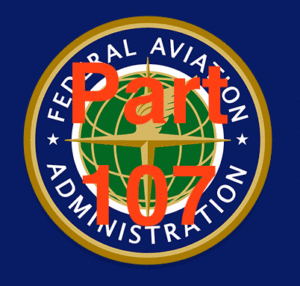 Part 107, the Small UAS Rule, takes effect on Monday – and recreational drone operators as well as commercial drone pilots may have to take the Part 107 Test. The “Aeronautical Knowledge Test” costs $150 to take and, the FAA estimates, will require about 20 hours of studying. In addition to passing the test, drone operators must be over 16 and must undergo – and pass – a TSA background screening before they will be issued a Part 107 Remote Pilot Certificate with Unmanned Aircraft Rating: a drone license. John Goglia, a contributor to Forbes magazine, wrote yesterday detailing the results of his requests to the FAA for clarification on this point; the answers he received indicate that many hobby fliers will fall under the new Part 107 regulations, requiring the same Certificate as commercial drone operators.
Part 107, the Small UAS Rule, takes effect on Monday – and recreational drone operators as well as commercial drone pilots may have to take the Part 107 Test. The “Aeronautical Knowledge Test” costs $150 to take and, the FAA estimates, will require about 20 hours of studying. In addition to passing the test, drone operators must be over 16 and must undergo – and pass – a TSA background screening before they will be issued a Part 107 Remote Pilot Certificate with Unmanned Aircraft Rating: a drone license. John Goglia, a contributor to Forbes magazine, wrote yesterday detailing the results of his requests to the FAA for clarification on this point; the answers he received indicate that many hobby fliers will fall under the new Part 107 regulations, requiring the same Certificate as commercial drone operators.
Previously, hobby fliers were required only to register their drone in accordance with FAA regulations and to follow the FAA guidelines for safe flight. Only commercial drones were required to get a Section 333 Exemption, and the Small UAS Rule (Part 107) was widely understood to be the replacement for the onerous Section 333 Exemption process for commercial drones.
The FAA website seemed to agree on this point – but as Goglia found out, the devil is, as always, in the details. The FAA’s “Frequently Asked Questions” page about UAS addresses the question directly. Under the section “Does the new Small UAS Rule (part 107) apply to recreational UAS operations?” the answer states [emphasis mine]:
Part 107 does not apply to UAS flown strictly for fun (hobby or recreational purposes) as long as these unmanned aircraft are flown in accordance with the Special Rule for Model Aircraft (Section 336 of P.L. 112-95). Visit our “Fly for Fun” webpage for safety rules and guidelines that apply to recreational UAS operations. The small UAS rule codifies the provisions of section 336 in part 101 of the FAA’s regulations, which will prohibit operating a UAS in manner that endangers the safety of the national airspace system.
It’s the following phrase – “as long as these unmanned aircraft are flown in accordance with the Special Rule for Model Aircraft” – that counts. The FAA states that to fly for fun you have two options [emphasis mine]:
Option #1. Fly in accordance with the Special Rule for Model Aircraft (Public Law 112-95 Section 336). Under this rule, operators must:
- Fly for hobby or recreational purposes only
- Follow a community-based set of safety guidelines
- Fly the UAS within visual line-of-sight
- Give way to manned aircraft
- Provide prior notification to the airport and air traffic control tower, if one is present, when flying within 5 miles of an airport
- Fly UAS that weigh no more than 55 lbs. unless certified by a community-based organization
- Register the aircraft (UAS over 0.55 lbs. and less than 55 lbs. can be registered online at registermyuas.faa.gov; UAS 55 lbs. or greater must be registered through the FAA’s paper-based process)
Option #2. Fly in accordance with the FAA’s Small UAS Rule (Part 107). This requires operators to:
- Obtain a remote pilot certificate or be under the direct supervision of someone who holds such a certificate.
- Register the aircraft as a non-modeler at registermyuas.faa.gov
- Follow all the operating rules in accordance with the regulation
While a “community-based set of guidelines” would seem to be a pretty broad category, the fine print of the Special Rule for Model Aircraft adds in another piece: you must operate “within the programming of a nationwide community-based organization.” In other words, you must prove membership in a large organization – and the AMA is the only that the FAA currently recognizes as meeting their criteria, although they claim that they would accept any similar organization that they found to meet their guidelines.
And here’s another gotcha: FPV (first person view) flight is another exception. FPV flight – which is what all drone racing uses – doesn’t meet the FAA’s criteria for “operating within the guidelines” (which were probably developed before FPV flight existed.) Regardless of status as a hobby flier or a professional, ALL FPV fliers will need a Part 107 certificate. To circle back to the beginning, that means the operator must be 16 years old. Let’s hope that the 15 year old drone racing champion who recently won $2.5 million in Dubai has a birthday before the races come to Hawaii next year.
If all this seems confusing, it is: the plethora of documents and postings surrounding the new rule are sometimes in conflict with one another. But until a new rule or clarification is announced, hobby fliers who want to fly legally have two options: join the AMA or another, as yet undetermined, approved organization; or take the test.
And drone racers and other FPV fliers – start studying.
 Unmanned Aerial Vehicle The latest drone news
Unmanned Aerial Vehicle The latest drone news



